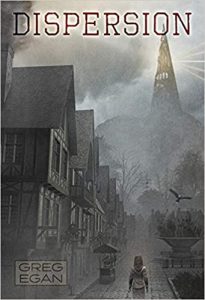Russell Letson Reviews Dispersion by Greg Egan
 Dispersion, Greg Egan (Subterranean Press 978-1-59606-989-3, $40.00, 158pp, hc) August 2020. Cover by David Ho.
Dispersion, Greg Egan (Subterranean Press 978-1-59606-989-3, $40.00, 158pp, hc) August 2020. Cover by David Ho.
In Dispersion, Greg Egan returns to a familiar but hardly comfortable mode: a variation on the guess-my-world’s-rules story in which the rules in question generate a world that is so fundamentally unlike ours that no amount of homely detail can entirely balance its alienness. The homely part includes the ordinary aspects of the story’s physical and social milieu – villages, gardens, town hall meetings, illicit affairs – that reads like a description of, say, rural England (or, since it’s Egan, Australia) before the Swinging ’60s. The almost impenetrably strange part is that the elements that make up the material world, and therefore all living bodies and organic material, are divided into six “fractions” that cannot interact with each other more than momentarily. There are six corresponding divisions of humankind, generally mutually invisible and untouchable, living in separate villages, eating their own fraction’s food, building with stone (which remains stable across fractions) and only sometimes able to work together on cooperative projects such as a dam or intervillage agreements – or, as in the case of the parents of viewpoint character Alice, to produce a child.
The workings of this universe are presented first as practicalities. In Alice’s initial visit to a neighboring village, she enters a tavern where the patrons are invisible to her but the tableware is visible:
and for an instant, all this unattended crockery looked like it might have been the aftermath of the previous night’s dining. But it only took the first mug rising to banish that notion. Before long, Alice could picture at least a dozen of the more demonstrative customers, as they gestured with their drinks or prodded the air with their ceramic forks…. but every tipped mug spilled some watery portion that the drinker’s mouth could not impede, forming puddles that drained away through the channels carved in the floor.
There is a new commonality: the Dispersion, a disease that behaves like our cancer or flesh-eating bacterial infection, slowly spreading and degrading the sufferer’s body until it can no longer function. The story’s through-line follows Alice’s efforts to discover the nature of the Dispersion and devise a cure. She visits the incompatible village of her father’s fraction to enlist his help in her research, and she sees there the beginnings of a fear-driven effort to expand the boundaries between villages, to keep out infection by increasing isolation, even if it means displacing neighbors. The rest of the story follows the analyses conducted by Alice and her cross-fraction team of investigators, while in the villages anxiety and mistrust turn into hostility, paranoia, and eventually violence.
Dispersion combines motifs from all over Egan territory: the social-ethical drama of people under extreme stress of Perihelion Summer and The Four Thousand, the Eight Hundred; the diseases of Distress, “Silver Fire”, and “Reasons to Be Cheerful”; and the gnarlier physics-and-math exertions of Schild’s Ladder or Incandescence or the “Luminous”/”Dark Integers” duo. It is this last motif-set that puts Dispersion right at the intelligibility limits of my own Eganverse – that is, of Egan stories that I can follow far enough to come out the other side with a good idea of what the fiction is attempting, even if I can’t parse all of the enabling devices and mathematical models. The Jesuits pounded enough metaphysics and epistemology into me so that I can wrangle, say, “Reasons to Be Cheerful” or “Mister Volition”, but since I topped out, mathematically, with intermediate algebra, I wind up taking large chunks of Advanced Egan on faith (as with, for example, parts of “3-adica”), while I found the Orthogonal trilogy and Dichronauts impenetrable. That still leaves plenty of Egan to work with.
The outlines of this meta/physical system are themselves dispersed through the narrative, introduced as effects become significant in a situation or as Alice’s research efforts bear fruit. The explicit outline comes from Timothy, a Dispersion sufferer who has worked out a mathematical model involving twelve dimensions and various interactions within them that accounts for the six fractions and ways people and objects from out-of-phase fractions interact in a complicated dance of subsets of the dimensions. The infection seems to have to do with cross-contamination of some kind, but Alice and her team cannot find the exact mechanism that produces it – until, finally, Alice does, at cost to herself.
This is a cousin to Edwin Abbot’s Flatland, on steroids laced with LSD, and I confess that in this case I could not follow the math. But I don’t read Egan for the math, no matter how essential it might be to his worldbuilding. The exotic cosmology is overlaid onto a nearly allegorical portrait of communities occupying overlapping but immiscible spaces, facing the same crisis but failing to come together to deal with it. And that is what I return to Egan for – the intertwined drives that I can parse and that clearly matter as much as the numbers: to know and then to do the right thing; to be effective and moral, no matter the difficulty or discomfort.
Russell Letson, Contributing Editor, is a not-quite-retired freelance writer living in St. Cloud, Minnesota. He has been loitering around the SF world since childhood and been writing about it since his long-ago grad school days. In between, he published a good bit of business-technology and music journalism. He is still working on a book about Hawaiian slack key guitar.
This review and more like it in the September 2020 issue of Locus.
 While you are here, please take a moment to support Locus with a one-time or recurring donation. We rely on reader donations to keep the magazine and site going, and would like to keep the site paywall free, but WE NEED YOUR FINANCIAL SUPPORT to continue quality coverage of the science fiction and fantasy field.
While you are here, please take a moment to support Locus with a one-time or recurring donation. We rely on reader donations to keep the magazine and site going, and would like to keep the site paywall free, but WE NEED YOUR FINANCIAL SUPPORT to continue quality coverage of the science fiction and fantasy field.
©Locus Magazine. Copyrighted material may not be republished without permission of LSFF.







